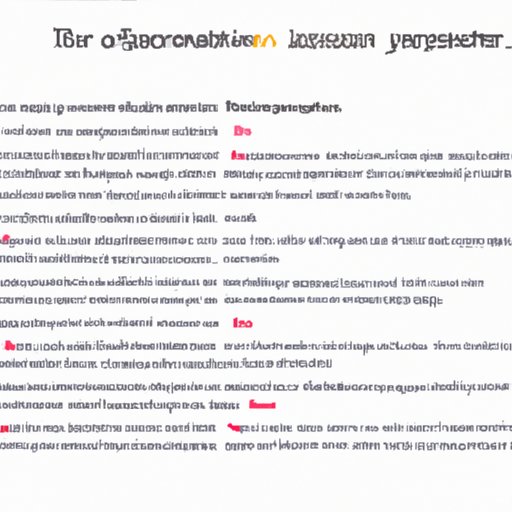Introduction
Insertion sort is a type of sorting algorithm that works by taking elements from an unsorted list one at a time and inserting them into their correct position within the sorted list. It is a simple algorithm that can be used to sort small collections of data quickly and efficiently. It is often used in educational settings as a way to teach students how sorting algorithms work.
The purpose of this article is to provide an in-depth explanation of how insertion sort works. We will look at the step-by-step process of the algorithm, examine graphical illustrations of the sorting process, compare insertion sort to other sorting algorithms, explore the benefits and limitations of using insertion sort, and discuss real-world examples and applications.
Step-by-Step Guide to Understanding Insertion Sort
Insertion sort is a relatively simple algorithm that can be broken down into a few steps. The first step is to take the first element from the unsorted list and insert it into its correct position within the sorted list. This is done by comparing the element with all the elements that come before it in the list until the correct position is found. Once the correct position is found, the element is inserted into the list and the process is repeated for the next element in the list.
The steps of the insertion sort algorithm are as follows:
- Take the first element from the unsorted list and insert it into its correct position within the sorted list.
- Compare the next element in the list with all the elements that come before it until the correct position is found.
- Once the correct position is found, insert the element into the list.
- Repeat the process for each element in the list until the list is completely sorted.
For example, consider the following unsorted list of numbers: [5, 3, 2, 4, 1]. Using insertion sort, the list would be sorted as follows:
- Take the first element (5) and insert it into its correct position in the sorted list (5).
- Compare the next element (3) with all the elements that come before it (5). Since 3 is less than 5, it should be inserted before 5 in the sorted list (3, 5).
- Compare the next element (2) with all the elements that come before it (3, 5). Since 2 is less than 3, it should be inserted before 3 in the sorted list (2, 3, 5).
- Compare the next element (4) with all the elements that come before it (2, 3, 5). Since 4 is greater than 3, but less than 5, it should be inserted after 3, but before 5 in the sorted list (2, 3, 4, 5).
- Compare the last element (1) with all the elements that come before it (2, 3, 4, 5). Since 1 is less than 2, it should be inserted before 2 in the sorted list (1, 2, 3, 4, 5).
The list is now sorted and the insertion sort algorithm has been completed.

An Illustrated Explanation of How Insertion Sort Works
In addition to understanding the step-by-step process of the insertion sort algorithm, it can be helpful to see a visual representation of how it works. The following diagram illustrates the insertion sort algorithm in action:

In this diagram, the blue arrows represent the elements being moved from the unsorted list to the sorted list, while the orange arrows represent the elements being compared during the sorting process. As you can see, the insertion sort algorithm takes each element from the unsorted list one at a time and inserts it into its correct position within the sorted list.
To further understand how insertion sort works, we can look at the following graphical illustration of the sorting process:

In this image, the blue boxes represent the elements in the unsorted list, while the yellow boxes represent the elements in the sorted list. The green arrows indicate which elements are being compared and inserted into their correct positions. As you can see, the insertion sort algorithm works by taking each element from the unsorted list one at a time and inserting it into its correct position within the sorted list.
A Comprehensive Overview of Insertion Sort Algorithm
Now that we have a basic understanding of how insertion sort works, let’s take a look at some of the advantages and disadvantages of using this algorithm.
One advantage of insertion sort is that it is a relatively simple algorithm to understand and implement. It is also very efficient for small collections of data, as it can sort the data quickly and easily. Additionally, insertion sort requires very little additional memory, making it ideal for systems with limited memory capacity.
On the other hand, insertion sort does have some drawbacks. One of the main drawbacks is that it is not very efficient for larger collections of data, as it can become slow and tedious. Additionally, insertion sort is not stable, meaning that it does not preserve the relative order of elements with equal keys.
When it comes to performance and complexity, insertion sort has a worst-case time complexity of O(n2) and an average-case time complexity of O(n2) as well. This means that the algorithm has a quadratic time complexity, meaning that it takes longer to sort larger collections of data. The algorithm also has a space complexity of O(1) since it does not require additional memory.

Comparing Insertion Sort to Other Sorting Algorithms
When it comes to sorting algorithms, there are several different types to choose from. To help you decide which algorithm is best for your needs, let’s take a look at how insertion sort compares to other sorting algorithms.
One of the most popular sorting algorithms is quicksort, which has a worst-case time complexity of O(n2) and an average-case time complexity of O(nlogn). Quicksort is considered to be more efficient than insertion sort, as it can sort larger collections of data quickly and easily. However, quicksort is not a stable algorithm, meaning that it does not preserve the relative order of elements with equal keys.
Another popular sorting algorithm is merge sort, which has a worst-case time complexity of O(nlogn) and an average-case time complexity of O(nlogn). Merge sort is considered to be more efficient than insertion sort, as it can sort large collections of data quickly and easily. Additionally, merge sort is a stable algorithm, meaning that it preserves the relative order of elements with equal keys.
When deciding which sorting algorithm to use, it is important to consider the size of the collection of data, the speed of the algorithm, and the stability of the algorithm. All of these factors must be taken into consideration when choosing the best sorting algorithm for your needs.

Exploring the Benefits and Limitations of Insertion Sort
Now that we have a better understanding of how insertion sort works, let’s take a look at some of the benefits and limitations of using this algorithm.
One of the main benefits of using insertion sort is that it is a relatively simple algorithm to understand and implement. Additionally, insertion sort is very efficient for small collections of data, as it can sort the data quickly and easily.
On the other hand, one of the main limitations of using insertion sort is that it is not very efficient for larger collections of data, as it can become slow and tedious. Additionally, insertion sort is not a stable algorithm, meaning that it does not preserve the relative order of elements with equal keys.
Insertion Sort in Practice: Real-World Examples and Applications
Now that we have a better understanding of how insertion sort works and the benefits and limitations of using this algorithm, let’s take a look at some real-world examples and applications.
One of the most common applications of insertion sort is in sorting numerical data. For example, insertion sort is often used to sort numbers in ascending or descending order. Additionally, insertion sort can be used to sort lists of names alphabetically.
Insertion sort is also commonly used in industry. For example, insertion sort is used in database management systems to sort records in a database. Additionally, insertion sort is used in search engines to sort webpages by relevance.
Conclusion
In conclusion, insertion sort is a type of sorting algorithm that works by taking elements from an unsorted list one at a time and inserting them into their correct position within the sorted list. It is a relatively simple algorithm that can be used to sort small collections of data quickly and efficiently. Although insertion sort is not very efficient for larger collections of data, it can be useful for sorting small amounts of data. Additionally, insertion sort is commonly used in industry for tasks such as sorting records in databases and sorting webpages by relevance.
By understanding how insertion sort works and exploring its advantages and limitations, you can make an informed decision about which sorting algorithm is best for your needs.
(Note: Is this article not meeting your expectations? Do you have knowledge or insights to share? Unlock new opportunities and expand your reach by joining our authors team. Click Registration to join us and share your expertise with our readers.)
